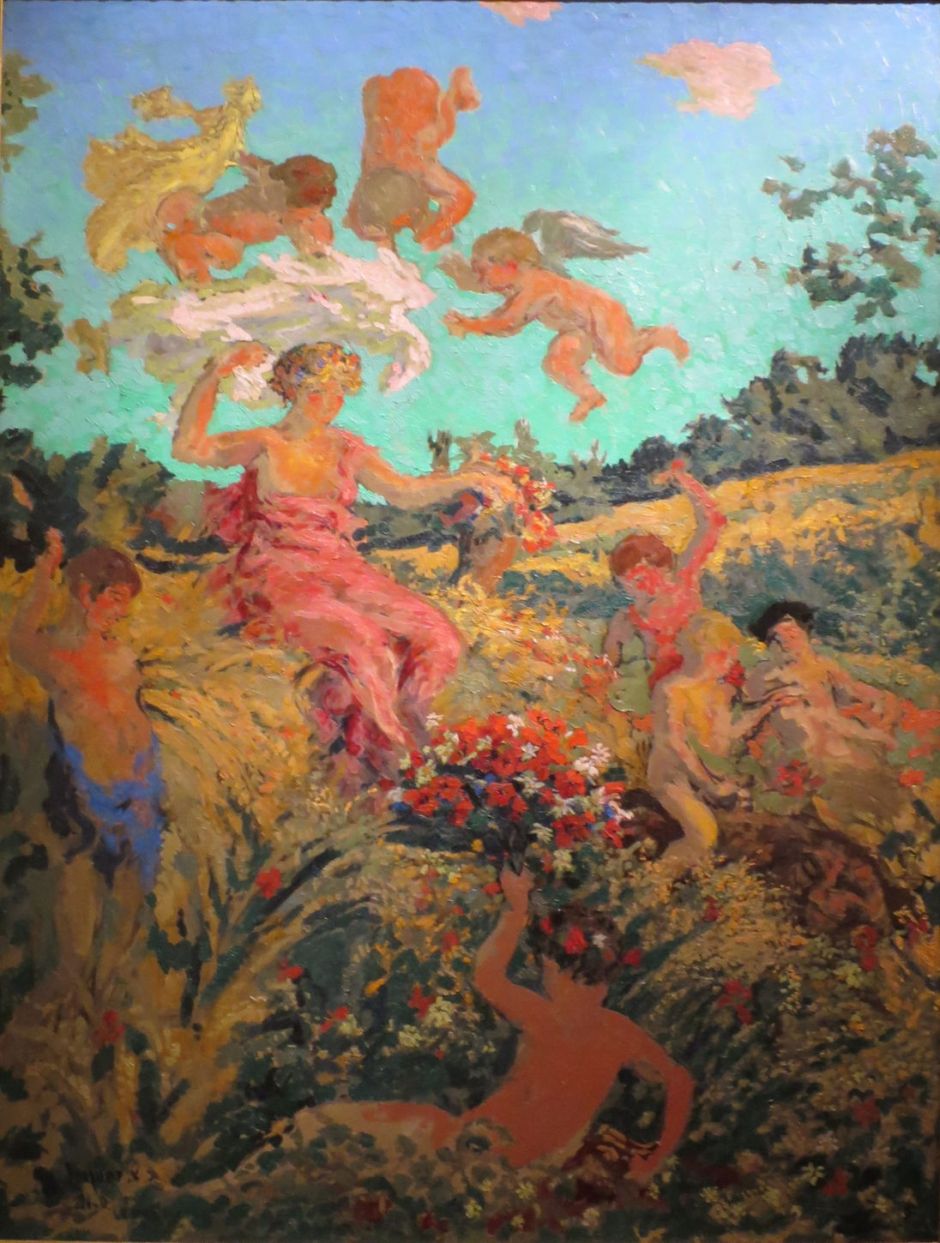Although the Nabis as a group had effectively dissolved well before 1910, several of its former members remained close friends. Their styles had changed, with higher chroma resulting from the influence of the Fauves and their love for painting in the Midi, the south of France. Among them, Ker-Xavier Roussel (1867–1944) had moved from static figurative scenes to mythological groups in landscapes, reminiscent of the classical narrative landscape tradition from Nicolas Poussin.

Until about 1910-11, Roussel hadn’t really tackled many well-known mythological stories, as far as I can see. The Rape of the Daughters of Leucippus from 1911 is firmly rooted in one of the most complex of classical myths, that of Castor and Pollux.
When Leda, wife of Tyndareus the king of Sparta, was seduced by Jupiter in the form of a swan, she conceived the twins Castor and Pollux, the first the mortal son of Tyndareus, the second the divine son of the god. In adult life, they wanted to marry Phoebe and Hilaeira, the Leucippides, who were actually not the daughters of Leucippus but of his brother.
However, the daughters were already betrothed to the cousins of Castor and Pollux, so the two sons of Leda abducted the women to Sparta, where they each had a son. The cousins later duped Castor and Pollux in a cattle raid, so the twins tried to steal their cousins’ cattle. This led to the death of Castor, and the deaths of the cousins too. Following the intervention of Jupiter, Castor and Pollux were turned into stars (catasterized), as the brightest in the constellation Gemini.
Roussel’s magnificent painting shows Phoebe and Hilaeira in the foreground (detail below), with the twins on their horses in the distance. Its style is a long way from the artist’s days with the Nabis.


Rural Festival, Summer from 1911-13 lacks narrative, but places its mythical figures in a harvest landscape of high chroma.

In Eurydice and the Serpent, a pastel from 1915, Roussel shows the fateful introductory scene in the well-known story which took the master musician Orpheus into the Underworld. Shortly after Orpheus and Eurydice had married, she was bitten by a snake, and died in her husband’s arms. The conventional painting made of this shows that last moment in Eurydice’s life; Roussel chooses a few moments earlier, with the snake seen on the ground in front of her.

For his painting of The Infancy of Jupiter, made in 1919-20, Roussel used one of the media popular with the Nabis, distemper on canvas, which had also been popular during the early Northern Renaissance. This shows one version of the myth, that the young god was raised by the nymph Amalthea, who had to hide the boy from Saturn by suspending him from a tree – which placed him in between the dominions ruled by Saturn, of Earth, heavens and sea.

The Sleeping Diana from 1924 returns to the simpler motif of the goddess asleep under the watchful eye of one of her devotees, as a deer comes to drink at the pool between them.

Roussel’s later pastel paintings are, in my opinion, some of his finest works, and worth seeking out in the Musée d’Orsay, where they have some of his best examples. Among these is his Old Silenus on a Donkey, painted in 1925-27.
Silenus was the King of Nysa, a companion, tutor and drinking partner to Bacchus, who like the god was often seen drunk. When unable to walk or stand, he was usually seen astride a donkey, as shown in this superb harvest-time scene.
In 1926, he was the second recipient of the Carnegie Prize. He remained close to Vuillard and Bonnard throughout his career, and undertook several joint projects to decorate buildings such as the art museum in Wintertur, and private villas.

Sadly, Roussel’s narrative period seems to have faded during his later career, when he painted in pastel this Reclining Female Nude (c 1930).

This late painting of Women in a Landscape in the Île de France from about 1932-35 is reminiscent of those earlier works.
Roussel died at his home in l’Étang-la-Ville on 6 June 1944, just two months before the Allies liberated Paris.
If you love the paintings of Pierre Bonnard, I urge you to seek out those of Ker-Xavier Roussel. As you have seen, he has a very distinctive and individual style, and his pastels are sublime.

